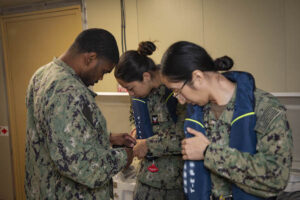
Story by Petty Officer 2nd Class Travis Decker
Naval Medical Forces Atlantic
JOINT EXPEDITIONARY BASE LITTLE CREEK-FORT STORY, Va. – The U.S. Navy conducted the first ever technical test of an Expeditionary Medical Unit (EMU) aboard the expeditionary fast transport USNS Cody (T-EPF 14) at Joint Expeditionary Base Little Creek-Fort Story, July 15-26.
The primary goal of the technical test was to verify the Cody will be able to support the EMU Role 2 (R2) capability to conduct forward resuscitative care (FRC) in the Expeditionary Fast Transport (EFT-14) afloat environment.
EMUs are a cutting-edge medical support systems with personnel from EMU-1 designed to provide R2 level healthcare. R2 healthcare includes medical treatment, advanced trauma management, and emergency medical treatment to include damage control surgery, emergency surgery, and continuation of resuscitative care. The EMU’s capability will enhance medical support for various military and humanitarian missions, ensuring comprehensive care from the sea to the shore.
“One of the biggest challenges in operational medicine is transporting the patient to the caregivers, or vice versa,” said Capt. Joseph Fitzpatrick, the officer-in-charge of Expeditionary Medical Unit (EMU) 1, “EPF platforms can potentially do both by establishing a fast moving, multidisciplinary, expeditionary medical asset than can serve as a bridge between vessels and the shore for the care and transport of injured or ill warfighters.”
The Cody has a modified O-2 deck, the deck a level above the main deck of the ship, that is designed to better support a medical mission. It has more dedicated space, power receptacles, and deck reinforcement to accommodate the specialized equipment needed by the EMU. EPF-14 has also been outfitted with an elevator and larger rigid-hulled inflatable boat (RHIB) deck designed for more efficient patient movement regardless of the method of arrival. There are plans already being undertaken for two more of this type of EFT ship configuration.
“The intent of this exercise was to verify that the equipment payload designed for the EMU was compatible with the layout of EPF-14 and that the electrical load required was within the Ship’s inherent capacity,” explained Fitzpatrick.
“Months of thought and planning by the contract team has been invested into designing the equipment and layout for the EMU, and they were without the ability to physically apply it to the ship … until now. The challenges to overcome throughout these two weeks have been marrying the concept to the execution, with expert advice from all medical specialties involved.
“Limitations in space required creative rearrangement of larger equipment, and lack of storage and secure points required innovative input from all parties involved: the contractors, the logisticians, the medical staff (physicians, nurses, and corpsman), and the MSC crew, to plan for improvements to this and future EPFs.”
EMU equipment is contained within ten 20-foot equivalent units (TEUs), which facilitates the storage and transport of both the authorized medical allowance list and dental allowance list items. These primarily commercial off-the-shelf items are protected by environmental control systems when at sea, ensuring their readiness and functionally across the spectrum of warfare during naval operations.
“Navy Medicine is leaning forward into supporting our fleet, Marine force, and the joint force right now by providing medical and surgical capabilities for the future fight,” said Capt. Lenel Boamah, director of maritime operations at the Bureau of Medicine and Surgery. “This is just one thing that we’re doing. This is just a single part of a much vaster scope of capabilities that Navy Medicine is building in the expeditionary arena.”
Expeditionary Medicine (EXMED) is but one part of the capabilities of Navy Medicine. EXMEDs provide standardized, modular, scalable combat service support and medical/dental capabilities to an advanced base environment across the entire range of joint military operations. These EXMEDS consist of the Expeditionary Medical Facility (EMF) hospitals, EMU’s and Forward Deployed Preventive Medicine Units (FDPMU).
Following the completion of the technical test, the EMU crew departed, but they will return for future deployments, and will be the ones setting the standard. With the first EMU onboard, the USNS Cody will be able to provide important medical care for emergencies at sea, including critical care, immediate damage control, mental health support, long-term care, and basic medical needs. This will help military personnel at sea by filling in medical need’s gaps.
“I feel it is an exciting time in Navy Medicine,” said Fitzpatrick with a grin. “We have always fought to provide high quality care wherever and whenever needed, but today we expand that capability farther and farther forward with this platform and the other EXMED systems. By focusing our attention on the expeditionary needs of the Navy warfighter and bringing comprehensive medical care forward to them, we are going to save lives! I intend to build and train team of expeditionary caregivers prepared to exceed the expectations of effectiveness of the ship.”
EMU 1 is a part of Navy Medicine Readiness and Training Command (NMRTC) Jacksonville; established on Oct. 1, 2018, NMRTC Jacksonville supports warfighters’ medical readiness to deploy and clinicians’ readiness to save lives. NMRTC Jacksonville, under Naval Medical Forces Atlantic (NMFL) regional authority, includes five Navy Medicine Readiness and Training Units in Albany and Kings Bay, Georgia; and in Jacksonville, Key West, and Mayport, Florida.
NMFL, headquartered in Portsmouth, Virginia, delivers operationally focused medical expertise and capabilities to meet Fleet, Marine and Joint Force requirements by providing equipment, sustainment and maintenance of medical forces during combat operations and public health crises. NMFL provides oversight for 21 NMRTCs, logistics, and public health and dental services throughout the U.S. East Coast, U.S. Gulf Coast, Cuba, Europe, and the Middle East.
Navy Medicine – represented by more than 44,000 highly-trained military and civilian health care professionals – provides enduring expeditionary medical support to the warfighter on, below, and above the sea, and ashore.